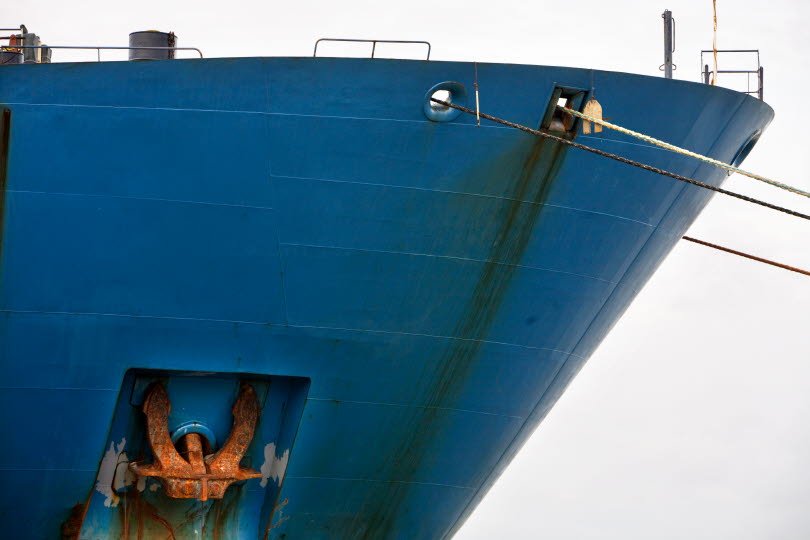EU ETS should also cover smaller vessels

A recent VTI report and working paper study the cost impacts of EU’s climate policy package “Fit for 55” (FF55) for freight transport to, from and in Sweden.
In July 2021, the European Commission presented the FF55 package of proposals for several instruments that together will contribute to achieving the EU’s stricter climate goal of at least 55 per cent lower net emissions of greenhouse gases by 2030. In a working paper “The cost impacts of Fit for 55 on shipping and their implications for Swedish freight transport” [1] VTI has described FF55. In short, it can be said that these are proposals for partly reworked, partly new legislation in the climate area. The policy instruments include expanding the Emissions Trading System (EU ETS) to shipping, while at the same time abolishing tax exemptions on marine fuel, introducing compulsory emission reductions and expanding infrastructure. If the proposed instruments are introduced, it means that maritime transport costs will increase and shipowners and other operators will be incentivised to make different types of adaptations. Axel Merkel, Joar Lind, Emma From, Karin Ek, and Inge Vierth, all from VTI, conducted a study in the autumn of 2022. On December 1st, they delivered their findings to the National Institute of Economic Research.
The report (in Swedish) and the working paper (in English) comprise estimated fuel cost increases for various segments within freight shipping as well as estimates of the adaptation effects, i.e., changed choice of mode, port and vessel as a result of increased fuel costs. Since FF55 is still being negotiated, different scenarios are being developed to consider uncertainties about what will apply. The main scenario assumes that FF55 is designed according to the European Commission’s proposal, but also three alternative scenarios that adopt different designs of the Energy Taxation Directive (ETD) and the EU ETS are presented.
Ships with a gross tonnage of at least 5,000, i.e. the intended limit for inclusion in the EU ETS, account for 78 per cent of CO2 emissions from freight shipping. But these freight vessels make up only 56 per cent of all ships operating in Swedish ports to, from and within Sweden. This would mean that a significant part of CO2 emissions in maritime transport is not met and that operators could be tempted to make greater use of ships that are not covered due to their size.
“It is recommended that even smaller ships be immediately included in the EU ETS or that the EU should plan to send clear signals to the market that even ships with a gross tonnage of less than 5,000 tonnes will be included in the long term,” says Inge Vierth.
The estimated cost increases for shipping fuel vary across the different segments. In the main scenario, cost increases in the European Economic Area (EEA) are in the range of eleven to 42 per cent as a consequence of shipping being included in the EU ETS. The difference between the segments disappears in the scenario that assumes that ships with a minimum gross tonnage of 400 tonnes should be included in the EU ETS; in this scenario, the cost increases in the EEA for all ship segments are just over 40 per cent. The overall fuel cost changes resulting from the implementation of the EU ETS and ETD are then in the range of 17 to 48 per cent for traffic within the EEA and in the range of five to 21 per cent for traffic to or from the EEA.
When various adjustments are made to the estimated fuel cost increases for maritime transport, the main scenario results in a reduction of about 2 per cent in shipping on the Swedish territory and an increase of about 1 per cent in road transport. This means that 0.6 per cent of total freight transport
is moved from sea to land, the same applies to the other scenarios. For most of Sweden’s 14 coastal areas, it is estimated that goods volumes will decrease by about 1 per cent, but for the Gothenburg area, a 1 per cent increase is expected. Furthermore, tonne-kilometres (with no territorial restriction) with Ro-Ro vessels are modelled to decrease by 16 per cent and tonne-kilometres with Ro-Pax vessels to increase by one per cent, indicating that some transfer would occur.
The change in total logistics costs is estimated in the main scenario to be around 0 per cent and in the strictest scenario to around 2 per cent. Increased logistics costs are estimated for goods transported by ship only or in transport chains that comprise shipping, but the overall scenario is that the studied climate policy instruments for shipping do not produce significant secondary effects.
“We see a need to develop information about fuel consumption and emissions from international shipping as a complement to existing statistics for domestic shipping and information regarding where and how ships in traffic to, from and within Sweden bunker fuel. We see also a need to expand the analytical capabilities for European and global instruments considering, among other things, the FF55 package,” says Inge Vierth.
Furthermore, it is suggested that a thorough analysis of FF55’s recommendations for the freight transport sector should be carried out and that the recommendations regarding, for instance, the inclusion of road transport in the EU ETS, should also be included in the analyses as soon as specific policy designs are discussed. This would allow for a more detailed, complete, and reliable description of how FF55 can be expected to affect freight transport costs.
Text: Tiina Mauritzell
Translated by: CBG Konsult & Information AB
Don´t miss out on our news – subscribe now!
Stay informed with the latest research and news from VTI. Sign up for newsletters, sent by e-mail four times a year.

